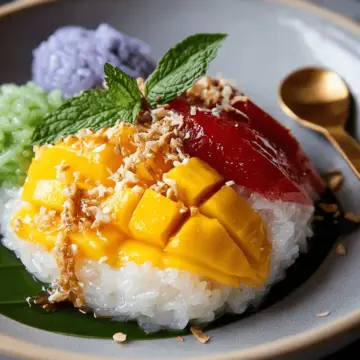Introduction to Thai Mango Sticky Rice
Why Thai Mango Sticky Rice is a Must-Try Dessert?
If you’ve never tasted Thai Mango Sticky Rice, you're in for a delightful experience! This iconic dessert masterfully combines elements that tantalize the senses—sweet, salty, fruity, and even a bit crunchy. It’s a dish that not only satisfies your sweet tooth but also offers a beautiful visual feast that brings a bit of Thailand right to your table.
The key to Thai Mango Sticky Rice lies in its simplicity and quality ingredients. The glutinous rice makes for a wonderfully sticky texture, while the rich coconut milk brings in creaminess that pairs harmoniously with the juicy, ripe mango slices. Don’t skimp on the mangoes! Choosing high-quality varieties, such as Ataulfo mangoes, is essential to achieving the perfect balance of flavors.
But what really sets this dessert apart? The topping! A sprinkle of toasted mung beans adds a delightful crunch that elevates the entire experience. It’s no wonder this dessert is trending around the globe. Ready to give it a try? Check out our Thai Mango Sticky Rice recipe, and let your culinary adventure unfold! If you’re eager for more, delve into our complete guide on the history of this indulgent treat here.

Ingredients for Thai Mango Sticky Rice
To create this delightful Thai Mango Sticky Rice Recipe, you'll need a few key ingredients that come together to wrap your taste buds in a warm, sweet embrace. Here’s what you need:
Coconut Sticky Rice
- 1 cup white glutinous rice: Often labeled as sweet rice, this is the star of the dish. Look for long-grain varieties from Thailand for the best texture.
- ⅔ cup coconut milk: A must-have for getting that rich, creamy texture. Check out this coconut milk guide for tips!
- ½ teaspoon salt: Enhances the overall flavor.
- ½ cup sugar: Sweetness is key—choose the right amount for your taste.
Salted Coconut Sauce
- ½ cup coconut milk: For drizzling over the sticky rice.
- ¼ teaspoon salt: Just enough to balance the sweetness.
- 1 teaspoon rice flour: This will help thicken your sauce.
- 1 tablespoon water: To create your slurry.
Additional Ingredients
- 2 tablespoons shelled and split mung beans: These add a lovely crunch.
- 3 ripe mangoes: Preferably Ataulfo, as their sweetness and smooth texture elevate the dish—absolutely essential for this classic dessert.
With these ingredients, you're well on your way to crafting an authentic Thai treat that’s sure to impress friends and family alike!
Step-by-Step Preparation of Thai Mango Sticky Rice
Creating the beloved Thai mango sticky rice recipe can feel daunting, but with a little patience and careful attention to detail, you’ll be serving this iconic dessert in no time! Let’s break it down step-by-step.
Wash and Soak the Rice
Start by washing the rice to remove excess starch, which can make your dish overly sticky. Place 1 cup of white glutinous rice in a mixing bowl and cover it with cold water. Swish the rice with your hands for about a minute and then pour off the cloudy water. Repeat this process four more times until the water runs mostly clear.
Once washed, it’s time to soak the rice. Cover it with room-temperature water and let it soak for at least four hours or overnight. If you’re planning to make this recipe colorful by using naturally dyed water, remember to refrigerate the rice until you’re ready to steam it.
Steam the Sticky Rice
After your rice has soaked, it’s time to steam! First, prepare your steamer by bringing water to a boil. Drain the rice and place it in a steamer lined with a moist muslin cloth. Make sure to leave some space for the steam to circulate. Cover and steam for 20-25 minutes until thoroughly cooked. The rice should be tender and not crunchy in the middle—a must for a perfect result!
Prepare the Coconut Syrup
While the rice is steaming, let’s whip up the coconut syrup. In a small pot, combine ⅔ cup of coconut milk, ½ cup of sugar, and ½ teaspoon of table salt. For a delightful aroma, consider adding a pandan leaf to the mixture. Cook over medium heat until it starts bubbling, then remove from heat and cover. This syrup will add a deliciously sweet touch to your dessert!
Make the Salted Coconut Sauce
Don’t forget about the salted coconut sauce! Combine ½ cup of coconut milk, ¼ teaspoon of salt, 1 teaspoon of rice flour, and 1 tablespoon of water in a small pot. Cook over medium-high heat, stirring constantly until thickened. This adds a contrasting salty flavor to your dessert, balancing out the sweetness wonderfully.
Prepare the Crispy Mung Beans
To add a little crunch, prepare the crispy mung beans. Rinse 2 tablespoons of shelled and split mung beans, then simmer them in 2 cups of water for about 10 minutes. After this, drain and dry the beans. Sauté them in a lightly greased pan over medium-high heat until they turn golden brown and crunchy. These little gems will provide a delightful contrast to the creamy elements of the dish!
Assemble the Dessert
Finally, it’s assembly time! Slice your sweet, ripe mangoes and serve them alongside the sticky rice. Drizzle the aromatic salted coconut sauce over the rice and sprinkle the crispy mung beans on top for that perfect finishing touch.
And there you have it—a step-by-step guide to making the ultimate Thai mango sticky rice. Enjoy your creation with friends or family, and don’t forget to share your experience!

Variations of Thai Mango Sticky Rice
Black Sticky Rice Variation
For a unique twist on the classic Thai mango sticky rice recipe, consider using black sticky rice. This variation brings a beautiful deep purple hue to your dish, along with a slightly nuttier flavor. To make this version, combine ¼ cup black sticky rice with ¾ cup white sticky rice, following the same preparation method. Adjust the coconut syrup to ½ cup for a balanced sweetness. The contrast between the black rice and fresh mango creates an eye-catching dessert that is sure to impress!
Tropical Fruit Variations
Why stop at mango? The delightful base of sticky rice pairs wonderfully with a variety of tropical fruits. Pineapple, dragon fruit, or even papaya can elevate your dessert to new heights. Simply substitute the mango with your chosen fruit, and serve it alongside or layered with the sticky rice. Experimenting with different fruits not only enhances the presentation but also adds exciting flavors, making each serving a little adventure in taste.
Cooking Tips and Notes for Thai Mango Sticky Rice
Choosing the Right Mangoes
Selecting the perfect mango is key for your Thai mango sticky rice recipe. Look for ripe, sweet varieties like Ataulfo (also known as Manila or Champagne mangoes). These have a buttery texture and a rich sweetness that pairs beautifully with the creamy coconut rice. Avoid hard, under-ripe mangoes as they won’t offer that luscious flavor you're aiming for. For more tips on mango selection, check out this guide.
Importance of the Right Rice
Using the right type of rice is essential. Always opt for white glutinous rice, which creates the sticky texture this dessert is known for. Make sure it’s long-grain and ideally sourced from Thailand. As you prepare your Thai mango sticky rice, remember that washing the rice to remove excess starch before soaking makes a significant difference in texture. This step will ensure that your rice comes out perfectly chewy with every bite!

Serving Suggestions for Thai Mango Sticky Rice
Creative Plating Ideas
When serving your Thai mango sticky rice recipe, aim for a visually appealing presentation. Try layering the sticky rice in a small bowl and inverting it onto a plate for a neat mound. Add sliced ripe mangoes on the side and drizzle with your salted coconut sauce. A sprinkle of crispy mung beans on top not only adds crunch but a burst of color as well. Consider garnishing with a fresh mint leaf or a sprinkle of toasted sesame seeds to elevate the look even further.
Complementary Dishes
Pair your delightful dessert with a refreshing Thai iced tea or a light coconut milk smoothie for a complete meal experience. For a savory contrast, serve it alongside spicy dishes like pad thai or green curry, which enhance the sweetness of the sticky rice. This balance of flavors makes for an unforgettable dining experience that your guests will rave about long after the meal is over.
For more tips on traditional Thai flavors, check out Thai cuisine resources.
Time Breakdown for Thai Mango Sticky Rice
Preparation Time
The Thai Mango Sticky Rice recipe requires about 4 hours of soaking for the rice, so it's best to plan ahead. When you can, soak the glutinous rice overnight for the best texture.
Cooking Time
Once the rice has soaked, the actual cooking takes just 30 minutes. This includes steaming the rice and preparing the coconut sauce and crispy mung beans.
Total Time
In total, you're looking at approximately 4 hours and 30 minutes to create this delightful dessert. With some preparation and a little patience, you’ll be able to enjoy this iconic Thai treat!
Nutritional Facts for Thai Mango Sticky Rice
Calories
A serving of Thai mango sticky rice contains approximately 280 calories, primarily derived from the glutinous rice and coconut milk. While it's a comforting dessert, being mindful of portion sizes can help you enjoy it without overindulging.
Carbohydrates
Expect about 50 grams of carbohydrates per serving, making this dish an excellent source of quick energy. The sweetness of the mangoes, combined with the carbohydrate-rich rice, delivers a delightful balance of flavors.
Fats
This dessert has around 7 grams of fat, mainly from the coconut milk. While these are largely saturated fats, coconut milk is also celebrated for its potential health benefits, such as providing medium-chain triglycerides (MCTs), which can be a quick energy source.
For more insights into the nutritional value of coconut milk, check out Healthline’s guide on coconut milk benefits.
Now that you know the nutritional facts, are you ready to make your own delightful Thai mango sticky rice recipe? Don’t miss the chance to impress your friends with this iconic dish!
FAQs about Thai Mango Sticky Rice
Can I make Thai Mango Sticky Rice in advance?
Absolutely! You can prepare the coconut sticky rice and the salted coconut sauce a day ahead. Just ensure to store them in airtight containers. When you're ready to serve, gently reheat the rice and sauce to enhance their flavors.
What’s the best way to store leftovers?
Leftover Thai Mango Sticky Rice can be stored in the refrigerator for up to three days. Place it in an airtight container to prevent moisture loss. When you’re ready to enjoy it again, simply steam or microwave the rice, and warm the coconut sauce separately.
Are there any substitutes for glutinous rice?
If you can’t find glutinous rice, short-grain rice can be a substitute, but the texture and taste will differ. For a more authentic experience, many recommend sticking to glutinous rice as it provides that unique chewy texture we all love in a Thai mango sticky rice recipe.
Feel free to check out resources on glutinous rice here and for perfect mango choices here.
Conclusion on Thai Mango Sticky Rice
In summary, Thai mango sticky rice is more than just a dessert; it’s a delightful experience that combines textures and flavors in perfect harmony. This recipe offers an authentic taste of Thailand, making it easy to enjoy this iconic treat at home. Treat yourself and enjoy every bite! For more inspiration, check out this guide to coconut milk and explore how to pick the best mangoes.

Thai Mango Sticky Rice Recipe
Equipment
- steamer
- mixing bowl
- small pot
- sauté pan
Ingredients
Coconut Sticky Rice
- 1 cup white glutinous rice Make sure it is long grain and a product of Thailand.
- ⅔ cup coconut milk
- ½ teaspoon table salt
- ½ cup sugar
Salted Coconut Sauce
- ½ cup coconut milk
- ¼ teaspoon table salt
- 1 teaspoon rice flour
- 1 Tablespoon water
Others
- 2 Tablespoons shelled and split mung beans
- 3 sweet, ripe mangoes Preferably Ataulfo mangoes.
Instructions
For the sweet sticky rice
- Wash the rice by placing it in a mixing bowl and cover with cold water, then vigorously swish the rice with your hand to release loose starch. Pour off the cloudy water and repeat the process 4 more times or until the water runs mostly clear.
- Soak the rice with room temp water for at least 4 hours and up to overnight.
- Preheat the steamer by bringing it to a full boil over high heat. Drain the rice very well, shaking off excess water in a sieve until there is no more dripping. Line a steamer rack with moist muslin or a thin white tea towel and place the rice on the cloth.
- Steam the rice for 20-25 minutes over rapidly boiling water, until fully cooked through.
- While the rice is cooking, make the coconut syrup by combining coconut milk, sugar, and salt in a small pot. Cook over medium heat and immediately turn off once it starts bubbling.
- Few minutes before the rice is done, reheat the syrup so it is steaming hot then keep covered. When the rice is done, pour the syrup over the rice and let sit for 20 minutes.
- After 20 minutes, fold the bottom part of the rice up to the top to help redistribute the syrup, and let sit for at least another 20 minutes.
For the salted coconut sauce
- Stir the rice flour into the water until there are no more lumps.
- Combine the rice flour slurry, coconut milk, and salt in a small pot. Cook over medium high heat, stirring constantly, until it comes to a boil. Remove from heat and pour into a bowl. Let cool completely before serving.
For the crispy mung beans
- Rinse the beans in cold water and cover with about 2 cups of water in a small pot.
- Bring the water to a simmer, then immediately remove from heat and cover the pot for 10 minutes.
- Drain off the cooking water and rinse the beans in cold water. Lay them on a paper towel to dry.
- Toast the beans in a lightly greased sauté pan over medium high heat until dry and crunchy.
- Let cool on a plate. This can be kept in an airtight container for up to 1 month.
Assembly
- Serve the rice beside sweet, fresh cut mangoes. Spoon some salted coconut sauce over the rice and sprinkle with the crispy mung beans.





Leave a Reply